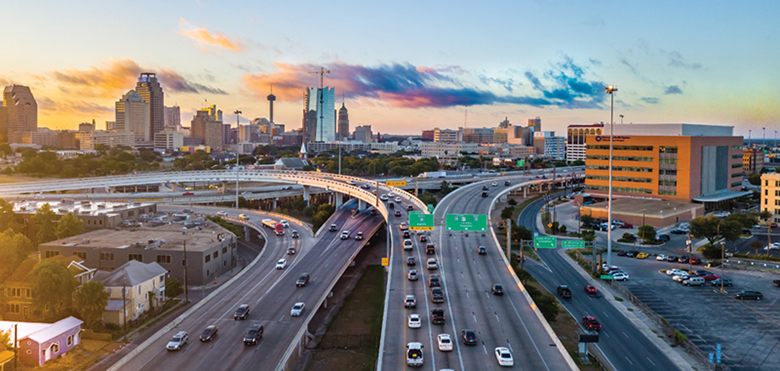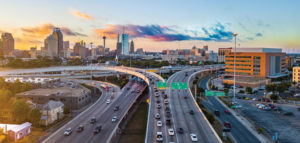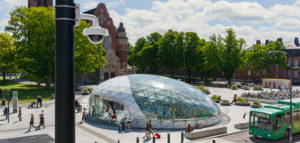Driving toward the future of intelligent traffic with network surveillance technology
Congested roadways. Bumper-to-bumper traffic. Beeping horns. Rush hour that actually felt like rush hour. About a year ago much of this disappeared—at least temporarily—as the nation went into lockdown and many people worked remotely.
While less traffic was refreshing, signs of congestion are starting to reappear. Not to be an alarmist, but the traffic problems we faced pre-pandemic—increased congestion, accidents, and roadside incidents—were never going to magically vanish.
As proof, we need look no further than research from the National Safety Council which sadly revealed that despite a sharp drop in traffic last year roadside fatality rates actually increased by 8 percent. Everything I’ve mentioned places an extraordinary spotlight on just how important it is to be forward-looking (rather than complacent) when it comes to solving our nation’s traffic problems.
Traffic Management Centers (TMC) are the nerve center for traffic management, but they face unprecedented challenges. Along with those I just mentioned, additional contributing factors, such as urbanization, low fuel costs, increases in population size, and the typical delays due to road maintenance activity, will continue to put pressure on TMCs as we move into the new decade. We must also consider new developments such as people migrating away from major metropolises to less crowded areas, which could increase commute time and generate more traffic.
TMCs run a 24/7 operation, providing oversight and keeping traffic moving and roads clear. Being able to clearly see what’s happening at all times and immediately detect issues as they arise with real-time situational awareness is a true force multiplier. Let’s discuss why this is the case and how network technology can help.
Why is real-time situational awareness so important?
Collecting and managing data in real time helps TMCs quickly ascertain each traffic situation, especially those incidents or situations that deviate from the norm. While those might be short-term benefits, traffic data can strategically provide useful insights for the long term as well, which can be used when planning for road maintenance, developing new infrastructure, and drafting additional traffic studies to name a few. Of course, to take advantage of that data, TMCs need to be able to easily collect it.
How intelligent traffic solutions act as a force multiplier
The ever-growing issues of traffic is one that affects millions of people each day. However, there’s a lot of innovation to counteract the impact of the usual traffic challenges, especially within the video surveillance area.
Today’s network video systems are incredibly robust and can easily integrate with different video and non-video devices and, more importantly, with other systems in themselves. This ease of integration allows fixed and mobile assets to easily share useful information. In turn, this provides a more complete picture across multiple locations than any single device could accomplish by itself, hence making it a true force multiplier enabler.
TMCs need a quick, clear view of what’s happening around the clock. This complete visibility can take place when network cameras are built on an open platform, enabling analytics and applications to reside and process video directly on those cameras. This eliminates the need to constantly stream video from every camera into the TMC, decreasing the cost of bandwidth, storage, and processing power compared to server-based applications.
With a smart network video solution, TMCs will quickly and automatically be alerted when there’s congestion, a stopped vehicle or someone driving in the wrong direction. By quickly obtaining the most pertinent information, operators can promptly act to keep traffic flowing as smoothly as possible.
Analytics really are the “brains” behind the TMC network in large part because they help combine multiple sources of data to create a more expansive, predictive view of how traffic is flowing, potential bottlenecks, and more. This is a huge plus not only for operators in traffic management but first responders, service and maintenance crews, and authorities to name a few.
Overcoming extreme conditions for optimal performance
Of course, there’s also the question of how conditions can impact the performance of network video solutions. What if the weather’s poor or it’s dark outside? What about the bright headlights when it’s dark outside? These are some of the main challenges TMCs must overcome. And they all pose significant problems for TMCs that are not well-equipped with cameras that are built to overcome these issues. After all, TMCs need to be able to operate around the clock.
A key component of network video is its ability to deliver high quality video in the most difficult lighting conditions including continuously changing back and reflective light, and especially in very low light conditions. For instance, Wide Dynamic Range (WDR) can minimize the effects of blinding headlights and reflections caused by sunlight and wet pavements.
For situations where there is no light at all, thermal cameras can step in to create images based on a person’s or vehicle’s heat signature. In addition, network video is much better engineered today to withstand extreme weather.
Solving traffic challenges cannot be done with high-quality network video cameras alone. Combining network video with traffic-specific applications and analytics, especially including Artificial Intelligence (AI) and Deep Learning, ensures data generated by network video will be streamlined, and the most useful metadata will be provided to the TMC.
With this wave of AI developed applications coming into the market, transportation engineers and urban planners can quickly and easily collect, monitor, and analyze traffic video data. A deeper understanding of traffic flow, road user behavior, and near-miss patterns allows state and city DOTs to make smarter decision on traffic infrastructure, and improve road safety and mobility for drivers and pedestrians. Giving TMC’s more detailed information about drivers, objects, causes, and anticipation of of accidents can provide better real-time detection, tracking, and response.
Establishing a surveillance system that uses some of these hot innovations can help turn any traffic monitoring from reactive to real-time and predictive.




